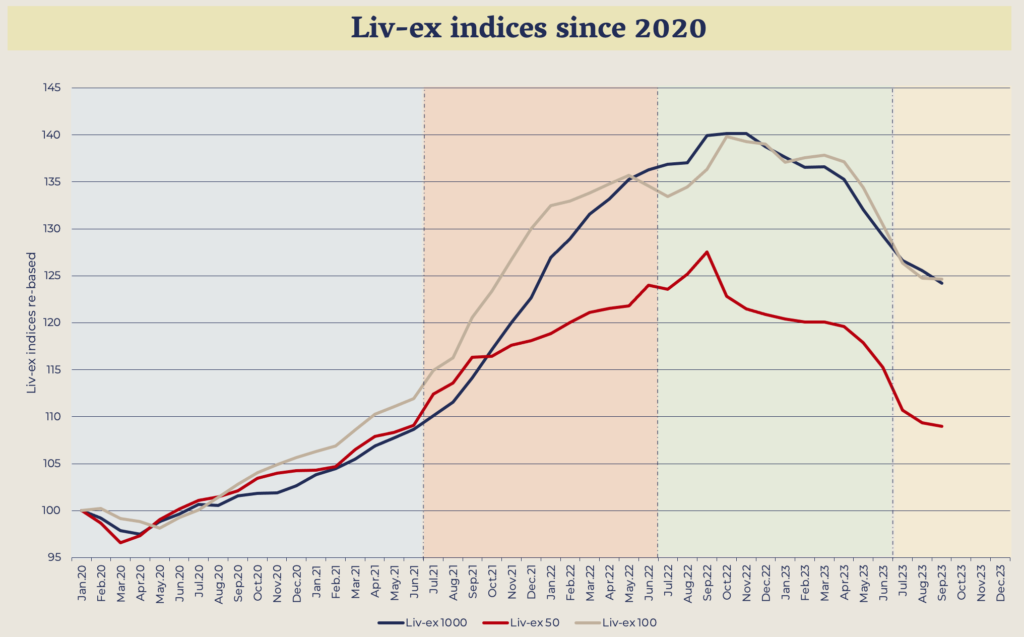The latest, tragic conflict in Gaza and Israel adds further fuel to an anxiety that has gripped the world for the past few years. And while wine prices are not directly linked to financial markets or central banks, our ailing economy has, undeniably, contributed to fine wine market behaviour over the past three years.
Background: fine wine’s latest rise and fall – a timeline

2020 – H1 2021
First, the Covid pandemic gave collectors excess time and money to explore fine wines, diverting spend share from luxury travel, and increasing wine market activity.
H2 2021 – H1 2022
As demand rose, prices increased and created a snowball effect, as newcomers entered the fine wine space, with many attempting to capitalise on short-term trades.
H2 2022 – H1 2023
Financial markets fell (albeit temporarily), distracting buyers away from wine. The latest fine wine demand cycle would have come to a natural end anyway, but it was made more abrupt by the combined effects of rising interest rates and economic uncertainty caused by the Russia-Ukraine conflict.
H2 2023
This past summer saw a drop in fine wine prices as seasoned collectors sought exit to capitalise on the latest price surge, while some more recent punters chose to liquidate in favour of a cash safety net. This created a temporary stock surplus, meaning anyone requiring a quick sale had to discount below market prices.
The next chapter: fine wine in 2024 and beyond
Wine enthusiasts receiving offers from traditional merchants in recent months will have noticed some attractive deals from the secondary market (with the caveat of inevitable risk on stock with an opaque history). Once this latest wave of excess availability has petered out, the “reset” of prices – to c.10-20% above end-2020 levels – will be complete. So, what happens next?
Given the current markers of economic and geopolitical risk, the next general wine pricing surge could be many moons away. In the meantime, our strategy for management of fine wine portfolios focuses on security, and on the longer-term advantages of holding exclusively perfect-provenance stock. Those considering the creation of such a fine wine collection today will capture the full benefits of wine’s unique characteristics as an asset class, namely:
- Fine wine is a tangible asset. Unlike stocks, bonds, and other financial assets, fine wine is a physical object that can be seen, touched, and tasted. In times of economic uncertainty, its limited downside risk make it a particularly relevant investment.
- Fine wine is a store of value. Its 50+ year track record as an asset class shows that its value tends to increase, especially for rare and sought-after vintages. This is because the supply of fine wine is limited, while the demand for it continues to grow.
- Fine wine is a hedge against inflation. In times of high inflation, the prices of many goods and services rise, while prices of fine wine tend to rise even faster. This is because fine wine is an established luxury in high demand among wealthy investors.
- Fine wine is a relatively liquid asset. While fine wine is not as liquid as stocks and bonds, it can still be sold relatively easily through auction houses or wine merchants. This makes for an easier exit than some other tangible assets, such as real estate or art.
- Fine wine can be enjoyed. Fine wine is a culturally and intellectually rewarding pursuit, to be enjoyed now and into the future. It makes for a trans-generational investment, and a meaningful legacy.

